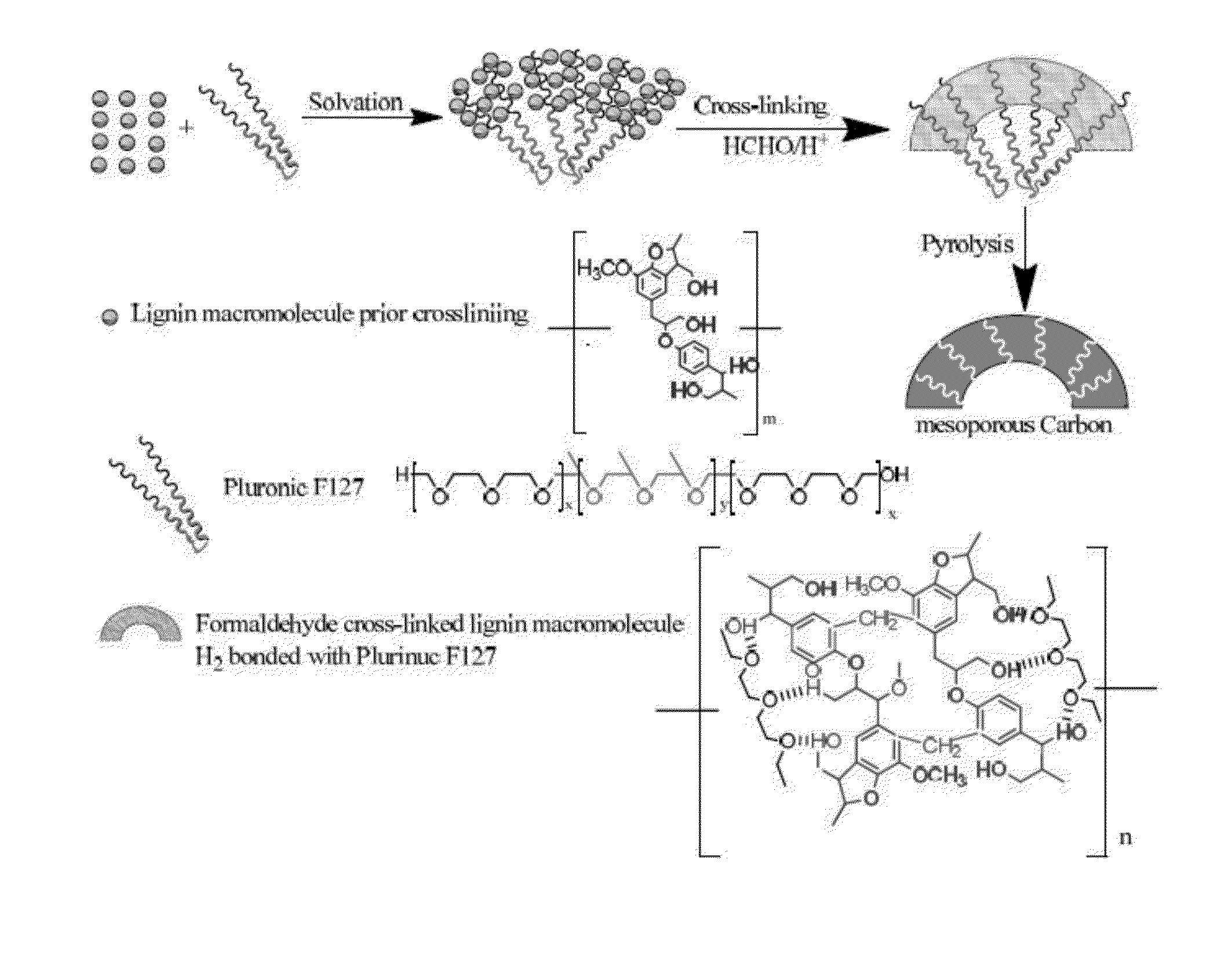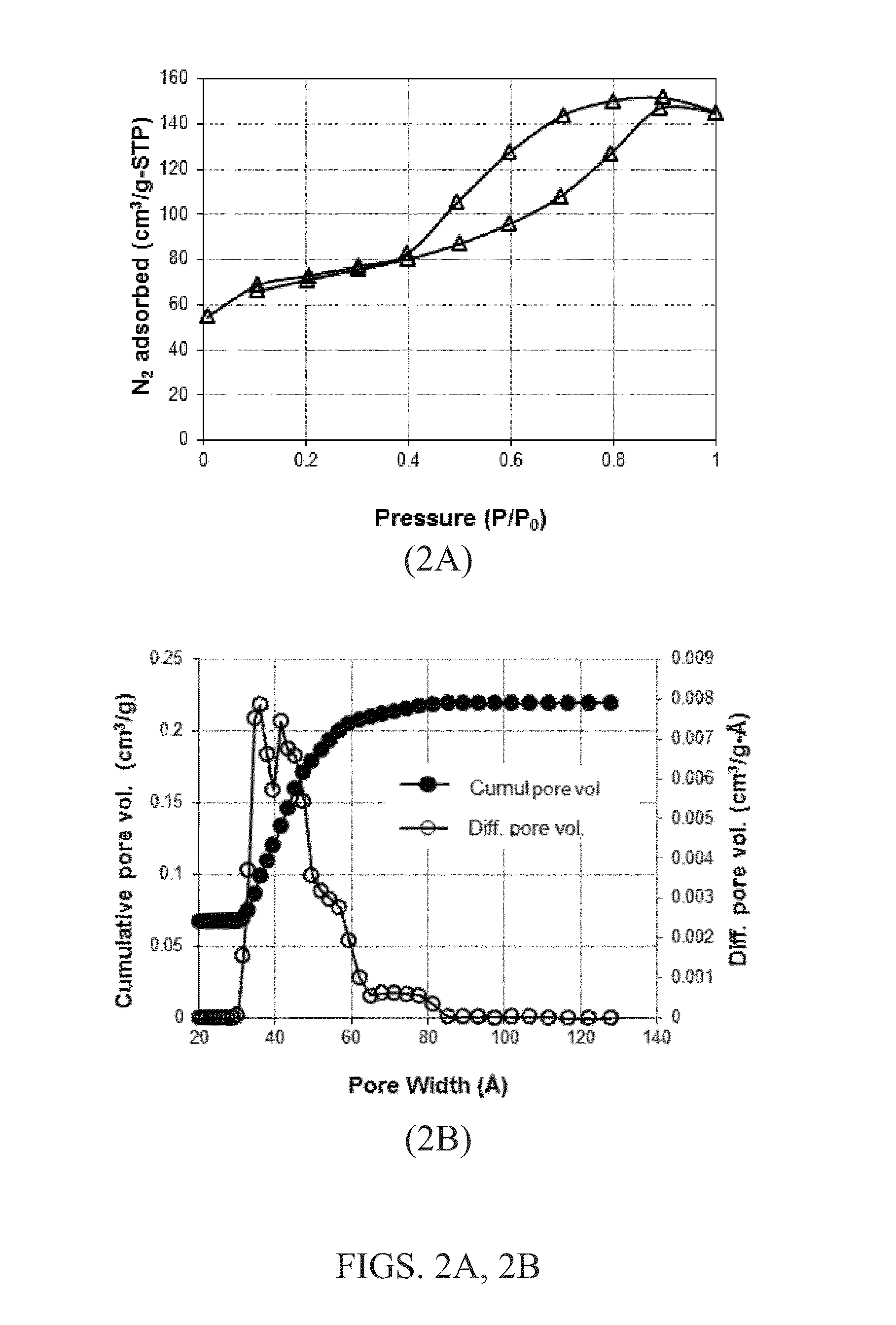Lignin-derived porous carbon composition, methods of preparation, and use thereof
a porous carbon and lignin technology, applied in the field of porous carbon materials, can solve the problems of lack of mesoporosity in existing lignin-derived carbon, high difficulty in converting lignin into such useful products, and general inability to adjust the pore size in existing methods, so as to reduce the carbon footprint
- Summary
- Abstract
- Description
- Claims
- Application Information
AI Technical Summary
Benefits of technology
Problems solved by technology
Method used
Image
Examples
example 1
Preparation of Phloroglucinol-Derived Mesoporous Carbon
Comparative Example
[0089]Phloroglucinol and a tri-block copolymer surfactant, Pluronic F127 (BASF) (1:1 w / w), were dissolved in a water-ethanol mixture (4.25:6.0 v / v) and crosslinked with formaldehyde in the presence of 200 μL hydrochloric acid (6 M) as catalyst at ambient (room) temperature (i.e., 18-28° C., or about 22° C.). After two hours of initiating the reaction, the excess water-ethanol mixture was decanted from the top of the reactant mixture and the polymer was cured overnight at 100° C. after which it turned to a red-brown solid matrix. The cured polymer was carbonized in a tube furnace under nitrogen flow by the following temperature profile: room temperature to 400° C. in PC / min, 400° C. to 1000° C. in 2° C. / min, maintaining at 1000° C. for 15 minutes, and followed by cooling to near ambient temperature under nitrogen flow.
example 2
Preparation of Lignin-Derived Mesoporous Carbon
[0090]Hardwood lignin isolated from black liquor of Kraft processed oak chips was mixed with a tri-block copolymer, Pluronic F127 (1:1 and 1:2 w / w), and dissolved in tetrahydrofuran (THF) in a round bottom flask. The lignin was crosslinked with formaldehyde (37%) in the presence of 600 μL hydrochloric acid (6 M) in 70° C. for 5 days. Note: the septum on the mouth of the flask needed to be sealed very cautiously as the reaction temperature is over the boiling point of THF (66° C.). Due to the highly heterogeneous and macromolecular nature of the lignin, a higher reaction temperature and a significantly longer reaction time were required to crosslink the lignin as compared to crosslinking of homogeneous small phenolics, such as resorcinol and phloroglucinol. After the reaction time, the flask was cooled and the reaction mixture was put on a Petri dish at ambient temperature and then slightly elevated temperature for several hours to slowl...
example 3
Formaldehyde-Based Crosslinking of Lignin with Acid Catalyst to Form Mesoporous Carbon
[0091]Methanol-soluble Kraft-processed hardwood lignin (5 g) and tri-block copolymer Pluronic F127 (in 1:1 and 1:2 ratio) were dissolved in THF under acidic conditions (200 μL 6M HCl) for several hours. After this, 2 cm3 of 37% formaldehyde solution was added and the mixture stirred for 3 days at 70° C. The reaction mixture was placed on a Petri dish at ambient temperature and then a slightly elevated temperature for several hours to slowly evaporate the solvent. The dried mass was scraped off of the Petri dish and carbonized in a porcelain boat in a tube furnace by the following temperature profile: RT to 100° C. at 10° C. / min, 100° C. to 400° C. at 1° C. / min, 400° C. to 1000° C. at 2° C. / min, and then maintaining the temperature at 1000° C. for 15 minutes. The pore textural characteristics were calculated by analyzing the N2 adsorption / desorption isotherms at 77 K. FIG. 1A shows an adsorption-des...
PUM
| Property | Measurement | Unit |
|---|---|---|
| mesopore size | aaaaa | aaaaa |
| pore diameters | aaaaa | aaaaa |
| mesopore size | aaaaa | aaaaa |
Abstract
Description
Claims
Application Information
 Login to View More
Login to View More - R&D
- Intellectual Property
- Life Sciences
- Materials
- Tech Scout
- Unparalleled Data Quality
- Higher Quality Content
- 60% Fewer Hallucinations
Browse by: Latest US Patents, China's latest patents, Technical Efficacy Thesaurus, Application Domain, Technology Topic, Popular Technical Reports.
© 2025 PatSnap. All rights reserved.Legal|Privacy policy|Modern Slavery Act Transparency Statement|Sitemap|About US| Contact US: help@patsnap.com



